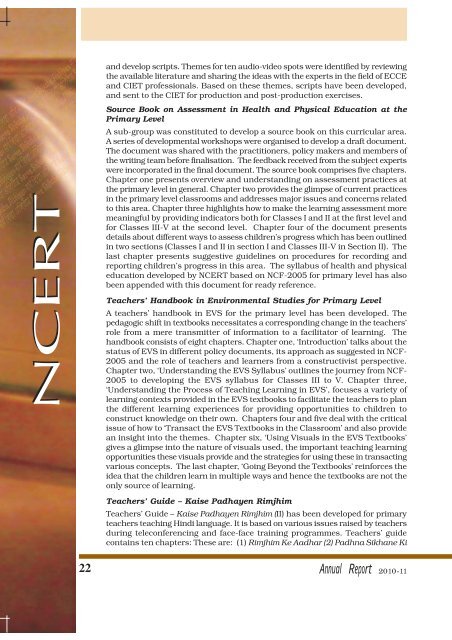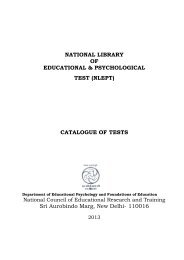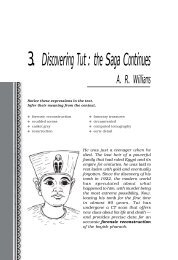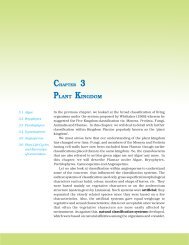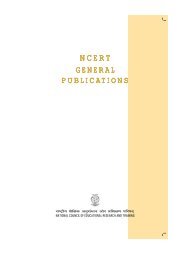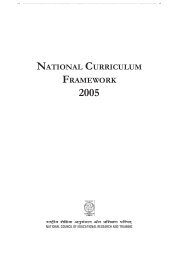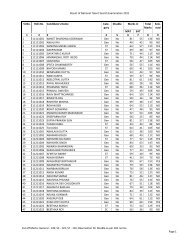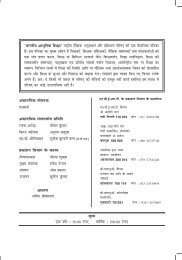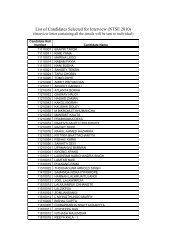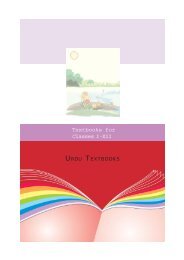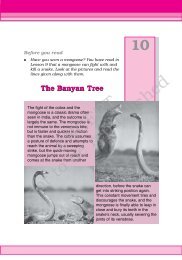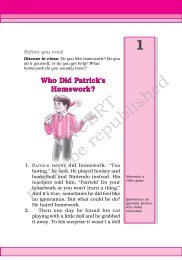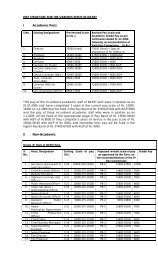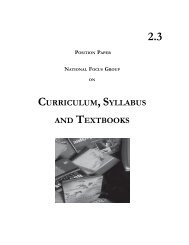Annual Report - National Council Of Educational Research And ...
Annual Report - National Council Of Educational Research And ...
Annual Report - National Council Of Educational Research And ...
You also want an ePaper? Increase the reach of your titles
YUMPU automatically turns print PDFs into web optimized ePapers that Google loves.
NCERT<br />
22<br />
and develop scripts. Themes for ten audio-video spots were identified by reviewing<br />
the available literature and sharing the ideas with the experts in the field of ECCE<br />
and CIET professionals. Based on these themes, scripts have been developed,<br />
and sent to the CIET for production and post-production exercises.<br />
Source Book on Assessment in Health and Physical Education at the<br />
Primary Level<br />
A sub-group was constituted to develop a source book on this curricular area.<br />
A series of developmental workshops were organised to develop a draft document.<br />
The document was shared with the practitioners, policy makers and members of<br />
the writing team before finalisation. The feedback received from the subject experts<br />
were incorporated in the final document. The source book comprises five chapters.<br />
Chapter one presents overview and understanding on assessment practices at<br />
the primary level in general. Chapter two provides the glimpse of current practices<br />
in the primary level classrooms and addresses major issues and concerns related<br />
to this area. Chapter three highlights how to make the learning assessment more<br />
meaningful by providing indicators both for Classes I and II at the first level and<br />
for Classes III-V at the second level. Chapter four of the document presents<br />
details about different ways to assess children’s progress which has been outlined<br />
in two sections (Classes I and II in section I and Classes III-V in Section II). The<br />
last chapter presents suggestive guidelines on procedures for recording and<br />
reporting children’s progress in this area. The syllabus of health and physical<br />
education developed by NCERT based on NCF-2005 for primary level has also<br />
been appended with this document for ready reference.<br />
Teachers’ Handbook in Environmental Studies for Primary Level<br />
A teachers’ handbook in EVS for the primary level has been developed. The<br />
pedagogic shift in textbooks necessitates a corresponding change in the teachers’<br />
role from a mere transmitter of information to a facilitator of learning. The<br />
handbook consists of eight chapters. Chapter one, ‘Introduction’ talks about the<br />
status of EVS in different policy documents, its approach as suggested in NCF-<br />
2005 and the role of teachers and learners from a constructivist perspective.<br />
Chapter two, ‘Understanding the EVS Syllabus’ outlines the journey from NCF-<br />
2005 to developing the EVS syllabus for Classes III to V. Chapter three,<br />
‘Understanding the Process of Teaching Learning in EVS’, focuses a variety of<br />
learning contexts provided in the EVS textbooks to facilitate the teachers to plan<br />
the different learning experiences for providing opportunities to children to<br />
construct knowledge on their own. Chapters four and five deal with the critical<br />
issue of how to ‘Transact the EVS Textbooks in the Classroom’ and also provide<br />
an insight into the themes. Chapter six, ‘Using Visuals in the EVS Textbooks’<br />
gives a glimpse into the nature of visuals used, the important teaching learning<br />
opportunities these visuals provide and the strategies for using these in transacting<br />
various concepts. The last chapter, ‘Going Beyond the Textbooks’ reinforces the<br />
idea that the children learn in multiple ways and hence the textbooks are not the<br />
only source of learning.<br />
Teachers’ Guide – Kaise Padhayen Rimjhim<br />
Teachers’ Guide – Kaise Padhayen Rimjhim (II) has been developed for primary<br />
teachers teaching Hindi language. It is based on various issues raised by teachers<br />
during teleconferencing and face-face training programmes. Teachers’ guide<br />
contains ten chapters: These are: (1) Rimjhim Ke Aadhar (2) Padhna Sikhane Ki<br />
<strong>Annual</strong> <strong>Report</strong> 2010-11


